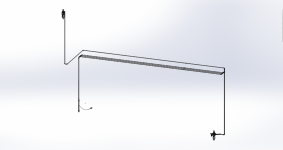WinterDeere
Elite Member
This one is 32", which is huge by modern hobbyist standards, but actually not one of the larger industrial-scale bandsaws Crescent made at that time. Their standard line went to 36", with a 38" HD option.interesting thread. what size or swing? is the saw, 17" or greater? sounds worth restoring the vintage machine
They or Tannewitz actually made some larger saws, into the mid-40-inch range, but they all had to be built into the factory floor, essentially over a pit for the lower wheel, to keep the saw table height at a usable level for an operator.
This isn't my first bandsaw, or even my tenth piece of vintage equipment, I used to have a whole shop full of 1000+ lb. vintage machinery from early 1900's. Right now, most of my shop is 1940's industrial and commercial models, more by coincidence than design.
I'll have to get a closer look at the original. The literature from Crescent claims their wheels are cast as one piece, and then the outer rim turned (both OD and ID shoulders) true, before balancing. So, if we believe their marketing literature, that original with the huge missing section should be one piece.Thank you for the explanation. I've done some foundary work, and went to bed after reading on your project and got to wondering how they could cast that wheel and keep the outer flange in one piece, much less keep it round. Banding a steel rim to affix to cast spokes does make a whole lot more sense.
In fact, as I look at your original wheel is it possible that the outer band was originally riveted to the spokes?
The replacement is of unknown brand, it could be Tannewitz, Colladay, Oliver... really anyone making 32-inch bandsaws 100 years ago. I believe that wheel is two piece, an outer steel hoop shrunk and welded onto a cast spoke and narrow rim wheel. Essentially, cast wheel, face and turn hub, then turn OD to accept a steel hoop. Weld hoop, heat to expand, and slip onto wheel, fixture in place while it cools and shrinks, then tack weld a dozen spots.
Philly used to be filled with foundries, but I don't think there are any left. There are some in Lancaster, who specialize more in agricultural stuff and fireplace doors, but I have had them make machine parts before. I don't think they're equipped to turn a 32" wheel, though... so we're talking foundry plus separate machine shop. Probably a few dozen Benjamin's for just this one part... and I already have another bandsaw. Tough call.Bottom line is if this is a project that matters, I would take both wheels down to your local Foundary and have a chat with them.
I work with machine shops on a pretty daily basis, so I guess I could ask one about making a new part in steel. It would look a little odd having a clean machined wheel totally open and visible on this cast antique, but it certainly would be functional! Right now, I'm leaning toward having someone spray weld this wheel to build it back up, then let my machine shop re-turn the rim to true it up after welding.I'd go with your third option have a blacksmith cast a new wheel and shrink a new wheel to it. Or most any machine shop could fabricate you a new wheel out of steel.
